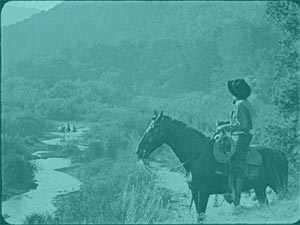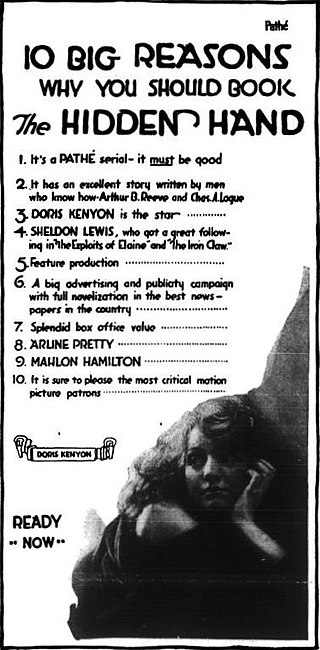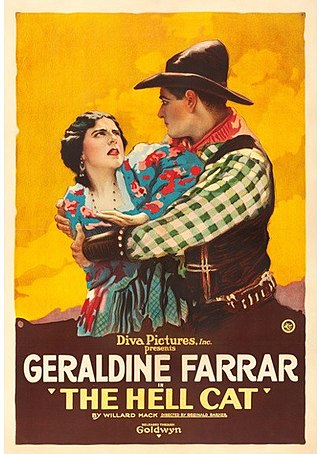
Hearts of the World is a 1918 American silent World War I propaganda film written, produced and directed by D. W. Griffith. In an effort to change the American public's neutral stance regarding the war, the British government contacted Griffith due to his stature and reputation for dramatic filmmaking.

Bucking Broadway is a 1917 American silent Western film directed by John Ford, probably his sixth feature film. Long thought to be lost, along with about 60 of Ford's 70 silent films, it was found in 2002 in the archives of the CNC. It was subsequently restored and digitized and is available on the Criterion Blu-Ray of John Ford's Stagecoach.

The Squaw Man is a 1918 American silent Western film directed by Cecil B. DeMille. It is a remake of DeMille's 1914 film of the same name, which is based upon a 1905 play by Edwin Milton Royle. The film was reportedly made as an experiment to prove DeMille's theory that a good film is based on a good story. It cost $40,000 to make and grossed $350,000. It would be remade again by DeMille in 1931. The 1918 The Squaw Man is a lost film with only the last reel extant.

The Mystery Ship is a 1917 American adventure film serial directed by Harry Harvey and Henry MacRae. The film is considered to be lost.

The Red Ace is a 1917 American adventure film serial directed by Jacques Jaccard. An incomplete print which is missing four chapters survives in the film archive of the Library of Congress.

The Brass Bullet is a 1918 American silent adventure film serial directed by Ben F. Wilson. It is now considered to be a lost film.

The Bull's Eye is a 1917 American film serial directed by James W. Horne. It is now considered to be a lost film.
The Lion's Claws is a 1918 American adventure film serial directed by Harry Harvey and Jacques Jaccard and starring Marie Walcamp and Ray Hanford. The serial, which had 18 chapters, is considered to be a lost film.

The Hidden Hand is a 1917 American film serial directed by James Vincent. This is a lost serial.

The Seven Pearls is a 1917 American silent action film serial directed by Louis J. Gasnier and Donald MacKenzie. Fragments are held by the Library of Congress.

The Legion of Death is a 1918 American silent drama film directed by Tod Browning, and released by Metro Pictures Corporation.

When a Woman Sins is a 1918 American silent drama film directed by J. Gordon Edwards and starring Theda Bara.

The Prussian Cur is a 1918 American anti-German silent propaganda film produced during World War I. Now considered a lost film, it is notable for telling the story of the Crucified Soldier.

You Can't Believe Everything is a 1918 American silent drama film directed by Jack Conway and starring Gloria Swanson. It is not known whether the film currently survives, and it is likely to be a lost film.

The Savage is a 1917 American silent drama film starring Colleen Moore and Monroe Salisbury that is set in Canada and was directed by Rupert Julian. The film is presumed to be lost.

The Love That Lives is a 1917 American silent drama film produced by Famous Players Film Company and distributed through Paramount Pictures. The film stars Pauline Frederick and was directed by Robert G. Vignola. The film is based on the story "Flames of Sacrifice", by Scudder Middleton.
The Bride's Awakening is a 1918 American silent drama film released by Universal Pictures and produced by their Bluebird production unit. Robert Z. Leonard directed the film and his then-wife Mae Murray was the star. A print of the film is housed at the EYE Institute Nederlands.

The Hell Cat is a 1918 American silent Western film produced and distributed by Goldwyn Pictures. Reginald Barker directed and Geraldine Farrar starred. It is not known whether the film currently survives.

The Unbeliever is a 1918 American silent propaganda film made towards the end of World War I. It was directed by Alan Crosland for the Edison Company towards its last days as a functioning film-making company. It stars Raymond McKee and Marguerite Courtot, who married a few years later, and Erich von Stroheim.

My Four Years in Germany is a 1918 American silent war drama film directed by William Nigh, based on the experiences of real life U. S. Ambassador to Germany James W. Gerard as described in his book. It is notable as being the first film produced by the four Warner Brothers, Harry, Sam, Albert and Jack, although the title card clearly reads "My Four Years In Germany Inc. Presents ...". The film was produced during the height of World War I and is occasionally considered propaganda.


















